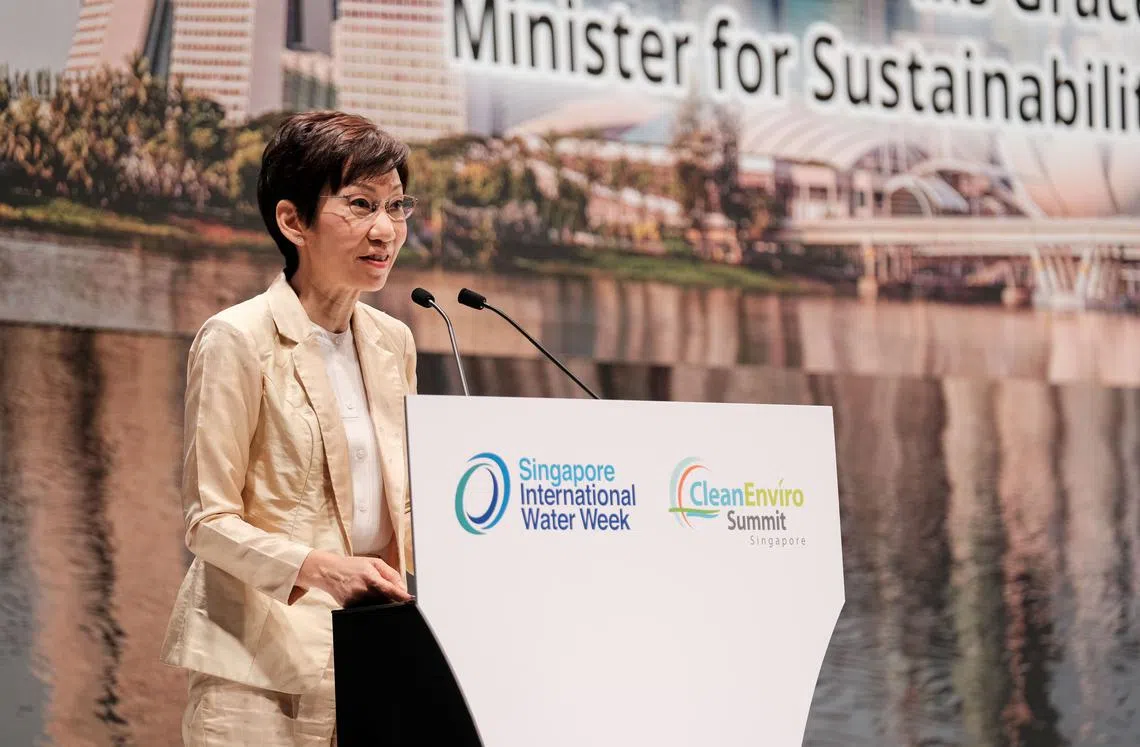'Blue' financing can make the difference in fight against climate change
Such funding can aid the transition towards a sustainable ocean economy, and the investment potential is said to be tremendous

Environmental concerns were the talk of the town last week, as over 15,000 leaders in governments, industry and academia from around the world gathered in Singapore for the CleanEnviro Summit Singapore (CESG) and the Singapore International Water Week (SIWW).
The events, coming on the back of Earth Day and the United Nations’ (UN) climate change panel calling for urgent action to mitigate and adapt to climate change, focused on accelerating such action.
“We do not have a lot of time left, and it is important to get to work as quickly as we can to look at how we can develop more sustainably, particularly through environment and water,” said Grace Fu, Minister For Sustainability and the Environment, at the joint opening of CESG and SIWW.

The SIWW this year, in particular, looked at the issue of coastal protection, with Singapore’s national water agency, PUB, taking on the role of coastal protection agency.
Coastal protection is particularly important to low-lying island nations like Singapore - and is nestled within the broader issue of ocean or marine preservation, which can be described as the conservation of marine resources.
Saving the seas
Ocean preservation is an issue that is less talked about but no less integral to the world’s efforts to fight climate change - and more so in Asia than many realise. Just as the world attempts to race towards achieving net-zero carbon emissions, it also needs to achieve a zero-pollution ocean.
“The ocean is our biggest ally when it comes to regulating climate and reducing climate change impacts,” says Charles Goddard, editorial director at Economist Impact, in an exclusive interview with The Business Times.
Economist Impact, part of The Economist Group, partners with corporations, foundations, non-governmental organisations (NGOs) and governments to drive the conversation around sustainability, health and the changing shape of globalisation.

“I couldn’t think of a more important single ecosystem as its role in underpinning the stability of the planet, its climate and life systems is so great.
“The ocean has absorbed more than 90 per cent of the excess heat and around 30 per cent of carbon dioxide emissions caused by human activities.”
But this has come at a considerable price: the ocean is warming and expanding at a worrying rate, and it is becoming more acidic, with serious consequences for marine life; the world is running against the clock to preserve its marine resources, Goddard says, with Asia being no exception.
“The truth is that the seas in and around Asia are among the most heavily used anywhere in the world. High levels of marine pollution, overfishing - including much illegal fishing - loss of biodiversity and the impacts of climate change are pushing the region’s marine environments into a dangerous downward spiral.”
Singapore, as a small, low-lying island nation, is particularly vulnerable in many ways to the ocean that surrounds it.
“Sea-level rise caused by a warming and expanding ocean is perhaps the major threat for the country, particularly given the large area of reclaimed land, but polluted and overfished seas are also potentially damaging for food security and for activities such as tourism and leisure,” Goddard said.
Marine pollution, caused by chemicals and plastics, are further threatening earth’s oceans - and these are magnified by the adverse impacts of climate change in the seas.
“Failing to act now is a risk we don't want to take,” Goddard says.
Blue financing
‘Blue’ financing can make the difference - this is capital or funding that can aid the transition towards a sustainable ocean economy, much as ‘green’ finance does on land. And the investment potential is considerable.
Back to Blue's report said that, based on current trends, around one-third of all assets under management will be focused on environmental, social and governance (ESG) concerns by 2025 - an estimated US$53 trillion worth. And it believes this "tsunami of capital" could present an unmatched opportunity to address the sources of marine chemical pollution.
“There are tremendous opportunities to invest in the ocean in a sustainable way, in the blue economy, and contribute to a healthy ocean while also providing income and return on capital,” Goddard says.
“Offshore renewables is one important example, but protection of coastal marine environments for sustainable tourism and leisure is another - tourism is the single largest part of the ocean economy - as are a range of other opportunities from sustainable aquaculture to nature-based solutions to coastal infrastructure.”
But there are challenges, he adds. For one, most ‘ocean’ investments continue to be towards less sustainable activities such as hard coastal infrastructure, ports, shipping, traditional energy and large-scale commercial fisheries, rather than ‘bluer’ activities such as sustainable tourism, energy and aquaculture, green ports and shipping, and ecosystem restoration.
“The second challenge is the gap in financing for such ‘bluer’ activities. The UN’s Sustainable Development Goal 14, ‘Life Below Water’, has barely 15 per cent of the funding needed to see the goals fully implemented, and this broadly seems to be the case elsewhere.”
Asia’s efforts
Goddard notes that multilateral development banks are stepping in to provide the foundational funding for some sustainable investments. The Asian Development Bank, for example, launched in 2019 its Action Plan for Healthy Oceans and Sustainable Blue Economies that expands financing and technical assistance for ocean health and marine economy projects to US$5 billion from 2019 to 2024.
The aim is to use this capital to attract much larger volumes of private capital into sustainable ocean investments, Goddard says, with some encouraging signs that it’s working, though most investments are still small in scale.
“Turning this situation (of highly stressed marine ecosystems in Asia) around will require coordinated, systemic action from each and every one of the stakeholders—governments, businesses, finance, consumers and citizens,” he adds.
And there are already encouraging results, such as the Indonesian and Vietnamese governments working alongside businesses and investors to address the leakage of plastic waste into the ocean.
In Australia, the billions of dollars of tourism revenue at stake every year has helped ensure that keeping the Great Barrier Reef in a healthy state is a vital economic priority. “Blue finance for nearby sugar farmers to reduce the run-off of nitrogen and pesticides into the waters around the reef shows how well-targeted capital can be a win-win for the economy, businesses and the environment. Initiatives like this also help build the resilience of the reef in the face of the challenges posed by warming seas.”
As for Singapore, Goddard has been encouraged by the government taking steps to gather more knowledge on how climate change could impact the marine environment; this includes a S$25-million investment, under the marine climate change science research programme, to tackle problems like rising sea levels, increasing sea surface temperatures, and extreme storm events.
But, overall, Goddard feels these positive efforts by various governments in the region are more the exception than the rule. “Blue finance is still in its infancy in the Asia region. Among the key obstacles are a lack of knowledge and understanding of the blue opportunity as well as a lack of investable projects at a sufficient scale to attract private capital. The risks too are perceived as being high.”
Copyright SPH Media. All rights reserved.


